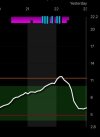Skater P
Active Member
- Relationship to Diabetes
- Type 1
I use walking to try and get a quick BG drop if it looks like I'm going hight, but I may not be walking for long enough.
It looks like cycling takes about 15 to register a drop (though there is a lag between my CGM and my bike computer) so it might be shorter, I may need to look at more than the most recent 6 rides.
It looks like cycling takes about 15 to register a drop (though there is a lag between my CGM and my bike computer) so it might be shorter, I may need to look at more than the most recent 6 rides.

